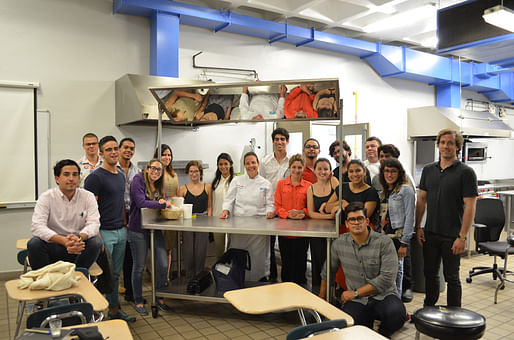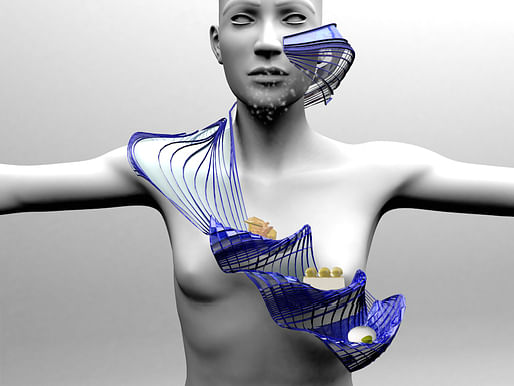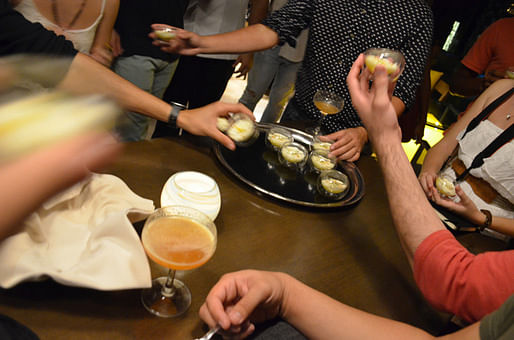

For the last few weeks, the AA Visiting School has been chopping and stirring and slicing in San Juan, Puerto Rico, for their "Play With Your Food" workshop. Participants are put through the rigorous paces that chefs face when designing new foods, and compare the methodology of cooking to architecture. At this intersection of food and architecture, cultures and personal histories collide for a (hopefully) mutually beneficial study of design methodology.
"Play With Your Food" has since ended, and we were in touch with the organizers and a few students to get a read on how the experimental workshop played out.

From the organizers, Jorge Mendez-Caceres, Drew Merkle and Miguel Miranda:
"Play With Your Food" draws parallels between architecture and cuisine, two seemingly very distant disciplines. What headway did the visiting school make in connecting these two worlds?
Architecture and Cuisine/Gastronomy/Mixology do seem to have no relation when they are first mentioned in the same forum. But, what we found that in any creative endeavor whether it is architecture/design, or that of conceptualizing and creating new types of culinary creations, the starting point is very much the same. Everyone has to begin with an idea, and evolve that through constant testing and re-testing; in design that can mean multiple iterations on the same 3D model, via option-eering or prototyping depending on the scale and necessity and likewise in the kitchen or behind the bar, this means reworking a certain dish or drink as a prototype that is re-investigated in much the same way, until it reaches the desired outcome.
We as directors sought to make this connection more apparent in one sense by bridging the gap in medium so to speak. The students learned by investigation and intensive research and tutorials on Rum, Architectural Design, Maya 3D modelling and cooking in the kitchen. Each group had a specific focus within the broader topic of Rum and Architecture that they chose to investigate, and from there they created at varying degrees, a connection between the two.

The Visiting School is open to "students and professionals of any discipline related to architecture, design and the city". Describe the breadth of participants in San Juan's workshop.
The participants ended up being an interesting mix. Each student had his or her own very interesting and unique perspective that helped to bring so much diversity to the school itself in the development of concepts and ideas. Many topics though based on the re-design of element/elements in the Rum-making process within Puerto Rico via an architecturally minded crowd, reached outside of the island in a broader sense. They were still however very grounded in the roots of the place, so it made for a very interesting end-scenario. In the future, we think it would be interesting to see what a professionally trained chef would create in 3D-modelling software, and how the original concept would completely diverge from this idea, but then find its way back to common ground through the addition of analogue prototyping methods.
How did San Juan's food culture specifically influence the workshop?
San Juan’s Food and mixology culture created a strong foundation for research that in the end led the students to create and develop their proposals. We had the chance to visit Rum Distilleries, experience many Rum tastings and lessons on mixology and/or cooking/gastronomy, which gave the students insight into how they would be working with the Rum in order to create their proposal.

The workshop was influenced in the culinary sense by the PR Food Crew, which is a group of young chefs in the Island who are exploring the use of local ingredients to create new takes on classic dishes, while also at times exploring new gastronomy techniques in food preparation, Chef Ariel at Augusto Restaurant, along with the help of the UPR Carolina, Escuela de Administración de Hoteles y Restaurantes. We also had a great course on mixology from the guys at La Factoria in Old San Juan, along with the master mixologists from Rums of Puerto Rico, who really helped transform some common misconceptions about Rum that the students may have had from the very beginning.
The multiple tours to various distilleries whether it be Bacardi, Serralles (makers of Don Q), or Ron del Barrilito, gave the students the ample amount of knowledge and first hand perspective of the process behind the making of rum. In the end, all things food and drink based helped to influence the direction of the workshop, but it was really up to the students to take this information, absorb it, and use it to their advantage, of which they did an extremely good job.

From a few participants of "Play With Your Food":
What interest, if any, did you have in food, prior to attending the workshop? Has that perspective changed, and if so, how?
Carlos Padrón: I used to be your regular food enthusiast. I love food; I mean who doesn’t love food? Without food you can’t live. On the other hand my knowledge pertaining to its conception and creation was almost non-existent. I was given a no-restrictions pass into that world and that has definitely changed how I view food. I now have an understanding or glimpses of the backstory or the process that allowed a particular food or dish to exist.

Jonathan W. Meléndez Davidson: I grew up in a family where the concept of socializing revolved around food. Ever since I can remember it has been a centerpiece to everyday, activity, celebration or holiday, but not once can I remember ‘questioning’ or studying any of these meals, outside of, “was it good? Or not”. My perspective on food has changed quite dramatically, I find myself questioning the origin, culture, and social connotation for almost every meal I have eaten since.
Laura Cristina Jiménez Burtell: Food is a double-edged sword; seen superficially, it is a matter of tasting and satisfying a need. However, I look at it from another perspective. As a designer, I take a look at the two processes that merge into one outcome, harvesting and preparation. Food opens infinite doors of feelings as it triggers multiple reactions in its consumers. It goes beyond tasting, which is only an opening act. The bare act of consuming it has the power to gather people, generating gratifying experiences. In another aspect, food is one of the loudest voices of culture. When you think about certain countries, the first thing that comes to mind is either their food or their designs and the various branches of each.

What aspect of food and drink did you find most interesting to try and relate to architecture? Or, what aspect of the built environment, and your particular design discipline, did you try and relate to food?
Carlos Padrón: The design and thought process that goes into creating a dish or a new take on any particular food is exactly the same that goes on in our discipline. It’s a research and process based design with relentless experimentation and copious amounts of trial and error. More so, the assembly logics that go into each of the dishes are exactly the same as the ones we employ. You would be surprised at how similar the disciplines are.
Jonathan W. Meléndez Davidson: My colleague Paola Gonzalez and I found ourselves interested in product production and by-products. As we studied local distilleries and their rum production process we realized that in the island rums base product is molasses which is a by-product of sugar cane production. We quickly established a connection between the use of by-products in rum production and local cuisine. Many of the traditional dishes in the island have originated from necessity, making a meal of what was available; in many cases this happened to be what other threw away. Once this connection was established we intended to create a design which would play around the idea of cultural and social phenomena surrounding cuisine and “waste”.

Laura Cristina Jiménez Burtell: In an ideal way, the process of generating food and drinks is in essence the same as the one that generates architecture, due to the investigation aspect that both processes require. The key connection between the branches of gastronomy and architecture is that only through investigation and experimentation the parameters for the best outcome will be established.
In your opinion, how will this workshop inform your practice / education overall?
Carlos Padrón: The workshop has definitely furthered my education, not only where it concerns design or architecture, but as an individual. It has enhanced the lens I use to look at the world, giving me even more insight as to why or how some things come to be. My position regarding design and the discipline is even more grounded now, and it confirms to me that I’m on the right path.
Jonathan W. Meléndez Davidson: The AA Play with your food workshop has helped me rediscover my curiosity for the unknown boundaries of an architectural education and practice.
Laura Cristina Jiménez Burtell: This workshop reinforced the vision I have, that whenever there is a process involved there are aspects of design that should be evaluated and appreciated. I believe that designs do not come from nothing, there is always a cultural background established, that should be taken into consideration, however through the investigation we can discover new ways to get it done based on the different reactions that are generated. I definitely look forward to taking the next version of this workshop because I enjoy the idea of breaking something down to see how it originated, because there is always a different possible outcome.

No Comments
Block this user
Are you sure you want to block this user and hide all related comments throughout the site?
Archinect
This is your first comment on Archinect. Your comment will be visible once approved.